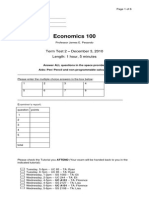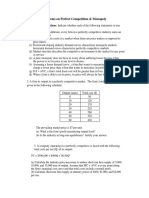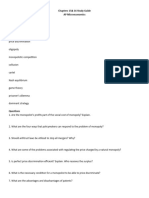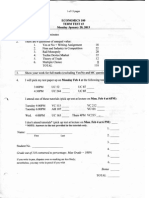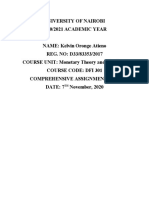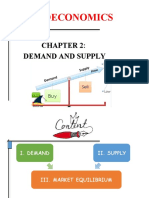0 ratings0% found this document useful (0 votes)
170 viewsEconomics 100: Answers
Economics 100: Answers
Uploaded by
examkillerThis document appears to be an economics exam consisting of multiple choice and written response questions. The exam covers topics such as long-run equilibrium in perfect competition, monopolistic competition, oligopoly, and monopoly. It contains 7 pages with 5 multiple choice questions at the end and 4 true/false questions requiring explanation. The exam tests the student's understanding of fundamental economic concepts through diagrammatic analysis and written explanations.
Copyright:
© All Rights Reserved
Available Formats
Download as PDF, TXT or read online from Scribd
Economics 100: Answers
Economics 100: Answers
Uploaded by
examkiller0 ratings0% found this document useful (0 votes)
170 views7 pagesThis document appears to be an economics exam consisting of multiple choice and written response questions. The exam covers topics such as long-run equilibrium in perfect competition, monopolistic competition, oligopoly, and monopoly. It contains 7 pages with 5 multiple choice questions at the end and 4 true/false questions requiring explanation. The exam tests the student's understanding of fundamental economic concepts through diagrammatic analysis and written explanations.
Original Title
Eco100 Pesando Tt2 2013f
Copyright
© © All Rights Reserved
Available Formats
PDF, TXT or read online from Scribd
Share this document
Did you find this document useful?
Is this content inappropriate?
This document appears to be an economics exam consisting of multiple choice and written response questions. The exam covers topics such as long-run equilibrium in perfect competition, monopolistic competition, oligopoly, and monopoly. It contains 7 pages with 5 multiple choice questions at the end and 4 true/false questions requiring explanation. The exam tests the student's understanding of fundamental economic concepts through diagrammatic analysis and written explanations.
Copyright:
© All Rights Reserved
Available Formats
Download as PDF, TXT or read online from Scribd
Download as pdf or txt
0 ratings0% found this document useful (0 votes)
170 views7 pagesEconomics 100: Answers
Economics 100: Answers
Uploaded by
examkillerThis document appears to be an economics exam consisting of multiple choice and written response questions. The exam covers topics such as long-run equilibrium in perfect competition, monopolistic competition, oligopoly, and monopoly. It contains 7 pages with 5 multiple choice questions at the end and 4 true/false questions requiring explanation. The exam tests the student's understanding of fundamental economic concepts through diagrammatic analysis and written explanations.
Copyright:
© All Rights Reserved
Available Formats
Download as PDF, TXT or read online from Scribd
Download as pdf or txt
You are on page 1of 7
Page 1 of 7
Last Name: ____________________
First Name: ____________________
Student Number: ________________
Economics 100
Professor James E. Pesando
ANSWERS
Term Test 1 November 29, 2013
Length: 1 hour
Answer ALL questions in the space provided
Permitted Aids: Pen/Pencil and non-programmable calculator. Any non-permitted
aid can and will be confiscated at the invigilators discretion.
________________________________________________
Please enter the multiple choice answers in the box below:
________________________________________________
Examiners report:
Question
Marks
Awarded
Marks
Available
1
18
2
14
3
12
4
12
TFU
24
MC
20
Total
100
Please check the Tutorial you ATTEND (Your exam will be handed back to you in the
indicated tutorial):
Tuesday, 2:10pm-3:00pm SS2105 TA: Jessica
Tuesday, 3:10pm-4:00pm GB119 TA: Steven
Tuesday, 4:10pm-5:00pm SS1069 TA: Jessica
Wednesday 1:10pm-2:00pm UC 163 TA: Yang
Wednesday 4:10pm- 5:00pm SS1085 TA: Yang
Thursday 11:10am-12:00pm BA1220 TA: Steven
Thursday 1:10pm-2:00pm UC52 TA: Steven
MC1
MC2
MC3
MC4 MC5
Page 2 of 7
Question 1 (18 points)
Beer is a perfectly competitive, constant cost industry in long-run equilibrium. Each
firm is identical and its cost curves have their usual shapes. The demand curve is
downward sloping.
(a) Show with the appropriate diagrams the long-run equilibrium for the industry and
a representative firm. Be sure to include market output (Q0), market price (P0),
and the output (q0) and profits (0) of each firm.
(b) Suppose there is reduction in wages for all workers in the beer industry, such
that the cost per unit of output falls by $2. Show on the previous diagram what
happens in the short-run to market output (Q1), market price (P1), and the output
(q1) and profits (1) of a representative firm.
(c) Will market price remain at the level in part (b) in the long-run? Explain your
answer. Do not show in diagram.
(d) Return to part (a). If one firm decides to advertise (a fixed cost), what will
Page 3 of 7
Question 2 (14 points)
A monopolistically competitive firm has the usual shaped cost curves and faces a
downward sloping demand curve. The monopolistically competitive firm is in long
run equilibrium.
(a) In an appropriate diagram, show the price (PM), output (QM), and profit (M).
Show, also, the allocatively efficient level of output (QAE).
(b) Suppose this firm is able to practice perfect price discrimination. In the previous
diagram, clearly label the marginal revenue curve (MRPD), the marginal cost
curve (MCPD) and the quantity of output (QPD).
(c) If the monopolistically competitive firm were able to engage in perfect price
discrimination, all else equal, what would happen to:
i. Total Surplus?
ii. Producer Surplus?
iii. Consumer Surplus?
iv. Efficiency?
Page 4 of 7
Question 3 (12 points)
Firm A and Firm B are the only two firms that produce cigars. If both advertise, each
earns a profit of $40 million. If neither advertises, each earns a profit of $120 million. If
one firm advertises but the other does not, the firm that advertises earns $150 million,
while the firm that does not advertise earns $30 million.
(a) Draw the payoff matrix that describes this situation and briefly explain what a
payoff matrix is.
(c)If these oligopolists formed a cartel, what actions would they choose? Why?
(b) In the absence of a cartel, what will the level of profits be for each firm? Why?
Page 5 of 7
Question 4 (12 points)
Consider a drug company that is a monopoly because of a patent. The demand
curve is downward sloping, marginal cost is $3 for all levels of output, and there are
no fixed costs.
(a) Show the short run equilibrium in an appropriate diagram. Be sure to include
market output (Q0), market price (P0), profits (0) and clearly label the average
total cost (ATC0) and marginal cost (MC0) curves.
(b) Show on the above diagram the market output (Q1) and Price (P1) if the patent
were removed. Is Q1 allocatively efficient? Explain.
TFU: Explain whether the following statements are true, false, or uncertain. All
marks are awarded for the explanation. (24 marks)
TFU1: The hot dog industry is perfectly competitive and in short run equilibrium. One
hot dog vendor did not complete high school and another hot dog vendor has an MBA
from UofT. The accounting profits are the same for each hot dog vendor. The vendor
with the MBA is more likely to remain in business in the long run.
Page 6 of 7
TFU2: In a perfectly competitive industry with identical firms, the full benefit of a
permanent $10 subsidy per unit of output will fall on producers in the long run.
TFU3: If a monopolistically competitive firm is operating on the inelastic portion of its
demand curve, it could increase profits by decreasing output.
TFU4: A bookseller is a monopolist, is profit maximizing, and is suffering economic
losses. The monopolist decides to switch strategies and to maximize total sales. As a
result, the bookseller will become profitable.
Page 7 of 7
MC. Identify the correct answer on the front cover. (20 points, 4 each)
MC1: If there are diminishing marginal returns in the
production of tea, then in the long run tea must be:
MC2: If a firm has high fixed costs and a low and constant
marginal cost, and is in long run equilibrium, that firm is:
MC3: A perfectly competitive firm is producing a quantity of
100 at price $10. The demand curve is downward sloping.
At that quantity, its total cost is $140, its fixed cost is $20,
and its marginal cost is $10. To maximize profits, this firm
should:
a) Increase output
b) Leave output unchanged
c) Decrease output
d) Shut down
e) Not enough information to determine
MC4: A monopolist is producing a quantity of 100 at price
$10. The demand curve is downward sloping. At that
quantity, its total cost is $140, its fixed cost is $20, and its
marginal cost is $10. To maximize profits, this firm should:
a) Increase output
b) Leave output unchanged
c) Decrease output
d) Shut down
e) Not enough information to determine
MC5: A perfectly competitive firm is earning zero accounting
profits. Thus:
a) The firm is earning positive economic profits
b) The firm will remain in the industry in the long run
c) Marginal costs are zero
d) The firm may exit the industry in the long run
e) None of the above
a) A decreasing cost industry
b) A constant cost industry
c) An increasing cost industry
d) Not enough information to determine
e) None of the above
a) A perfectly competitive firm
b) A monopolist
c) An oligopolist
d) Not enough information to determine
e) None of the above
You might also like
- Mgeb02 FinalDocument4 pagesMgeb02 FinalexamkillerNo ratings yet
- ECON 105 D100 Assignment 05Document4 pagesECON 105 D100 Assignment 05sarahabrahamNo ratings yet
- Chapter 8 Test BankDocument13 pagesChapter 8 Test BankMervat SabryNo ratings yet
- Chapter 8 - Ge Managerial EconomicsDocument11 pagesChapter 8 - Ge Managerial EconomicssaadNo ratings yet
- ECON 101 Final Practice1Document32 pagesECON 101 Final Practice1examkillerNo ratings yet
- Economics 100: Term Test 2 - December 4, 2009 Length: 1 Hour, 5 MinutesDocument6 pagesEconomics 100: Term Test 2 - December 4, 2009 Length: 1 Hour, 5 MinutesexamkillerNo ratings yet
- Eco100 Pesando Tt2 2010fDocument6 pagesEco100 Pesando Tt2 2010fexamkillerNo ratings yet
- Practice MCQ (CH 6 To CH 9)Document7 pagesPractice MCQ (CH 6 To CH 9)rhlvajpayeeNo ratings yet
- Eco101a Tutorial Problem Set 12Document2 pagesEco101a Tutorial Problem Set 12Rhythm's PathakNo ratings yet
- Solutions: ECO 100Y Introduction To Economics Term Test # 3Document10 pagesSolutions: ECO 100Y Introduction To Economics Term Test # 3examkillerNo ratings yet
- MicroEconomics Practice TestDocument7 pagesMicroEconomics Practice TestDavid BurfordNo ratings yet
- B+Micro+HA+4++problem+set UnlockedDocument12 pagesB+Micro+HA+4++problem+set UnlockedAzar0% (1)
- Final Exam 4Document4 pagesFinal Exam 4HealthyYOU100% (1)
- Tutorial 3Document14 pagesTutorial 3Apple' Mai LingNo ratings yet
- Microeconomics Chapter 7Document10 pagesMicroeconomics Chapter 7Pearl Lawrence100% (1)
- BECO575-Extra Problems 3 (CH 7, 8,9&10 - Market Structures)Document12 pagesBECO575-Extra Problems 3 (CH 7, 8,9&10 - Market Structures)Jamal Ezzi100% (1)
- BE Online Midterm Exam 202201Document6 pagesBE Online Midterm Exam 202201ching lamNo ratings yet
- BECO575-Worksheet 3 (CH 7, 8 And10 - Market Structures)Document11 pagesBECO575-Worksheet 3 (CH 7, 8 And10 - Market Structures)Sara HalabiNo ratings yet
- Chap 9.pure CompttvDocument9 pagesChap 9.pure Compttvdeva ayuNo ratings yet
- ME - Problem Set 6Document4 pagesME - Problem Set 6AbhiNo ratings yet
- Solution: ECO 100Y Introduction To Economics Term Test # 3Document14 pagesSolution: ECO 100Y Introduction To Economics Term Test # 3examkillerNo ratings yet
- Review QuestionsDocument5 pagesReview QuestionsNahid IbrahimzadeNo ratings yet
- 9. Perfect competitionDocument10 pages9. Perfect competitiondipak khimjiNo ratings yet
- Sample Exam Questions Chapter12Document8 pagesSample Exam Questions Chapter12elserry.comNo ratings yet
- Ec3099 ZB 2018Document6 pagesEc3099 ZB 2018Shawn MorganNo ratings yet
- 28d8633c121419cda48c0d9a622614d6_27f68bd319e3aca1d3f97af3bbb90014Document9 pages28d8633c121419cda48c0d9a622614d6_27f68bd319e3aca1d3f97af3bbb90014deepakdohare1011No ratings yet
- 2012 ZaDocument4 pages2012 ZaShershah KakakhelNo ratings yet
- Exam QuestionDocument11 pagesExam QuestionRicha MahajanNo ratings yet
- Intermediate Micro-II Practice TestsDocument3 pagesIntermediate Micro-II Practice Testsdishagoyal2994No ratings yet
- Exam 2 - Answer Key PDFDocument6 pagesExam 2 - Answer Key PDFMarjser Planta SagarinoNo ratings yet
- Assignment #2Document10 pagesAssignment #2Liyana Abdul RahmanNo ratings yet
- Market Structure QuestionsDocument2 pagesMarket Structure Questionsfavoursenessie4No ratings yet
- Econ 201 Final Exam: Special Codes 00000Document73 pagesEcon 201 Final Exam: Special Codes 00000brownb51No ratings yet
- ECO 101 Quiz 3-3Document6 pagesECO 101 Quiz 3-3Rokib SiddiqueNo ratings yet
- Tutorial Sheet 1Document2 pagesTutorial Sheet 1Samar EissaNo ratings yet
- Extra Practice QuestionsDocument4 pagesExtra Practice QuestionsJedNo ratings yet
- 15Document12 pages15RamiesRahmanNo ratings yet
- MS 602 - Topic 6 - Revision QuestionsDocument6 pagesMS 602 - Topic 6 - Revision QuestionsPETRONo ratings yet
- ME Problems PC MonopolyDocument7 pagesME Problems PC MonopolyDevan BhallaNo ratings yet
- Question Paper EndSem Exam - MEDocument3 pagesQuestion Paper EndSem Exam - MEVivek RajanNo ratings yet
- Economics For Managers 3rd Edition Farnham Test Bank 1Document26 pagesEconomics For Managers 3rd Edition Farnham Test Bank 1angella100% (56)
- Managerial Objectives 2Document7 pagesManagerial Objectives 2Sekla ShaqdieselNo ratings yet
- Review of Chapter 11Document8 pagesReview of Chapter 11visha183240No ratings yet
- Eco 101 Solved Problems Single Price MonopolistDocument5 pagesEco 101 Solved Problems Single Price Monopolistphineas12345678910ferbNo ratings yet
- Chapter 15 & 16 Study Guide Micro StudentDocument9 pagesChapter 15 & 16 Study Guide Micro StudentShahzad KouserNo ratings yet
- Assignment For EV MBA-7Document7 pagesAssignment For EV MBA-7Farhadismam IsmamNo ratings yet
- TutTest 3 - SolutionDocument9 pagesTutTest 3 - SolutionSoham KulkarniNo ratings yet
- Microeconomics Old Exam 3 ISBN 10 1429218290Document15 pagesMicroeconomics Old Exam 3 ISBN 10 1429218290carterkddNo ratings yet
- CH 9Document9 pagesCH 9ceoji100% (1)
- Bonus QuizDocument13 pagesBonus QuizAshley Ann StocktonNo ratings yet
- Year 13 Class Test 2021Document9 pagesYear 13 Class Test 2021Mikely FernandoNo ratings yet
- Chapter 14Document10 pagesChapter 14kang100% (2)
- INQUISITIVE TO STUDY - Set 6Document4 pagesINQUISITIVE TO STUDY - Set 6richmannkansahNo ratings yet
- 2010 Chpt9answersDocument6 pages2010 Chpt9answersmballas2012No ratings yet
- Micro CA SET 2Document3 pagesMicro CA SET 2dishagoyal2994No ratings yet
- R15 Firm and Market Structures - Q BankDocument12 pagesR15 Firm and Market Structures - Q Bankakshay mouryaNo ratings yet
- Exam Prep for:: Economics from the Outside In: Better Than Plowing and BeyondFrom EverandExam Prep for:: Economics from the Outside In: Better Than Plowing and BeyondNo ratings yet
- Beyond Earnings: Applying the HOLT CFROI and Economic Profit FrameworkFrom EverandBeyond Earnings: Applying the HOLT CFROI and Economic Profit FrameworkNo ratings yet
- Eco100y1 Wolfson Tt4 2013wDocument11 pagesEco100y1 Wolfson Tt4 2013wexamkillerNo ratings yet
- Eco100y1 Wolfson Tt2 2012fDocument12 pagesEco100y1 Wolfson Tt2 2012fexamkillerNo ratings yet
- Eco100y1 Wolfson Tt3 2013wDocument13 pagesEco100y1 Wolfson Tt3 2013wexamkillerNo ratings yet
- X - Efficiency TheoryDocument20 pagesX - Efficiency Theorysanyog.garg7386100% (1)
- Intermediate Part 1 PDFDocument148 pagesIntermediate Part 1 PDFNomanAliNo ratings yet
- Raghbendra Jha - Modern Public Economics (2009, Routledge)Document648 pagesRaghbendra Jha - Modern Public Economics (2009, Routledge)Just Breathe100% (1)
- Lesson Week 7 ADAS .PPTX - My NotesDocument49 pagesLesson Week 7 ADAS .PPTX - My NotesMartin van der VlistNo ratings yet
- Economics of Housing ExternalitiesDocument4 pagesEconomics of Housing ExternalitiesNima MoaddeliNo ratings yet
- DFI 301R2020 Comprehensive Assignment OneDocument7 pagesDFI 301R2020 Comprehensive Assignment OneKelvin OrongeNo ratings yet
- Value Investing (Greenwald) SP2018Document5 pagesValue Investing (Greenwald) SP2018YOG RAJANINo ratings yet
- Technology Firms MarketsDocument10 pagesTechnology Firms MarketsSravan KumarNo ratings yet
- 4.2. Perfect CompetitionDocument31 pages4.2. Perfect CompetitionAshwini SakpalNo ratings yet
- Economic Development Unit 1BDocument16 pagesEconomic Development Unit 1BIssah Marie HingabayNo ratings yet
- Chapter23 - Aggregate Expenditure and Equilibrium Output Part IIDocument14 pagesChapter23 - Aggregate Expenditure and Equilibrium Output Part IIAta Deniz BişenNo ratings yet
- Vydehi School of Excellence Exam Material Month: November Class: 11A English I. Revision Worksheets: Section - ADocument46 pagesVydehi School of Excellence Exam Material Month: November Class: 11A English I. Revision Worksheets: Section - AvaNo ratings yet
- Problem Set - Perfect Competition AnswersDocument3 pagesProblem Set - Perfect Competition AnswersKhushi GuptaNo ratings yet
- Ap22 FRQ Microeconomics Set 2 PDFDocument6 pagesAp22 FRQ Microeconomics Set 2 PDFHojung YiNo ratings yet
- Macroeconomics Basic TopicsDocument10 pagesMacroeconomics Basic TopicsReader50% (4)
- Supply and DemandDocument16 pagesSupply and Demandmahadishaon56No ratings yet
- Solution - Assignment PDFDocument7 pagesSolution - Assignment PDFQ bNo ratings yet
- Assignment-Ii Pme HSS1021Document1 pageAssignment-Ii Pme HSS1021Biswajeet MohapatraNo ratings yet
- Applied Economics - Demand and SupplyDocument11 pagesApplied Economics - Demand and SupplyJowjie TV100% (1)
- Microeconomics: Demand and SupplyDocument56 pagesMicroeconomics: Demand and SupplyThế KiênNo ratings yet
- Linear - Functions - Intersection - of - Straight - Lines Part 2Document26 pagesLinear - Functions - Intersection - of - Straight - Lines Part 2Abhijit NairNo ratings yet
- Inference and Arbitrage: The Impact of Statistical Arbitrage On Stock PricesDocument33 pagesInference and Arbitrage: The Impact of Statistical Arbitrage On Stock PriceshanniballectterNo ratings yet
- Intro To Macro Midterm Answer KeyDocument10 pagesIntro To Macro Midterm Answer KeyAigerim SerikkazinovaNo ratings yet
- Ec2010 T1 PDFDocument67 pagesEc2010 T1 PDFAlayou TeferaNo ratings yet
- UGC NET COMMERCE SOLVED PAPERSDocument544 pagesUGC NET COMMERCE SOLVED PAPERStwinklebeniwal100No ratings yet
- Solved There Are Two Firms in An Economy Each of ThemDocument1 pageSolved There Are Two Firms in An Economy Each of ThemM Bilal SaleemNo ratings yet
- Quiz Chap 3 - 4Document9 pagesQuiz Chap 3 - 4Kentzie RhodesNo ratings yet
- Briefs Jan PrepDocument193 pagesBriefs Jan PrepDavid BalocheNo ratings yet







